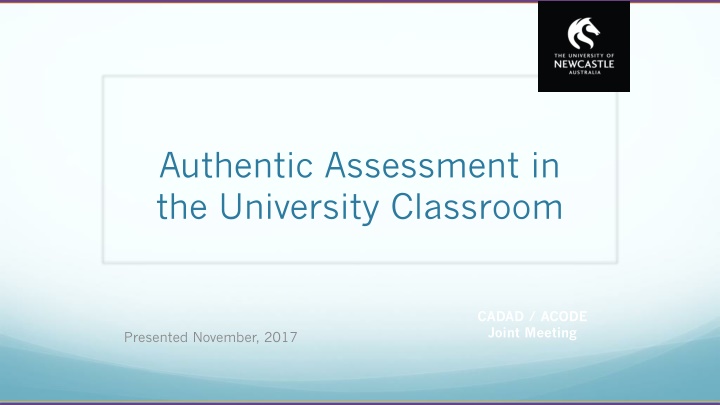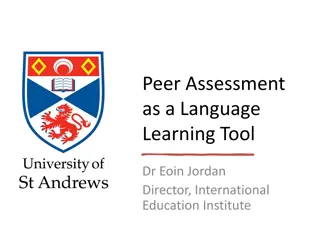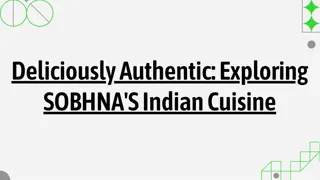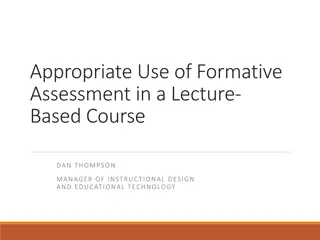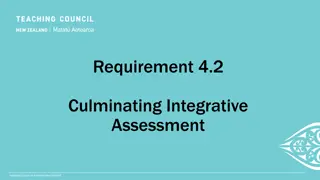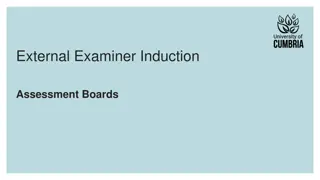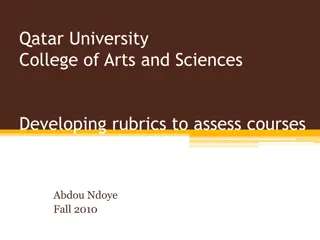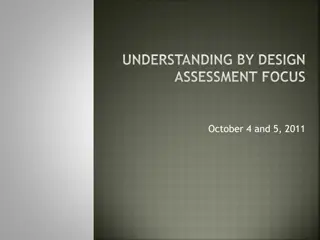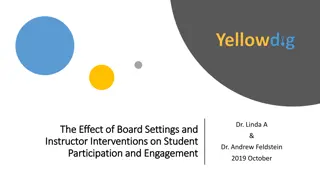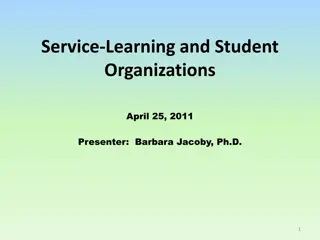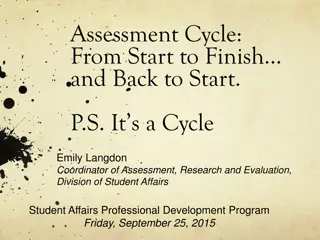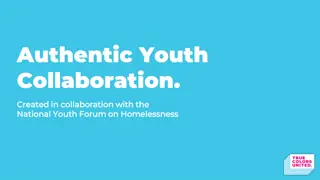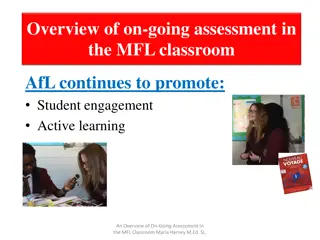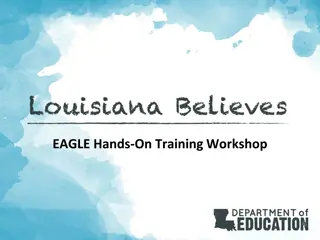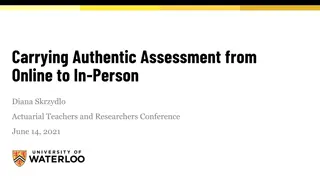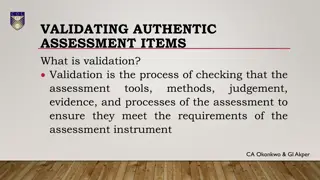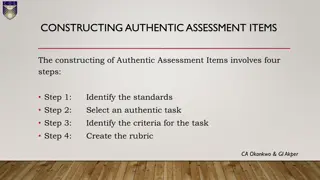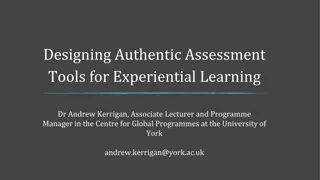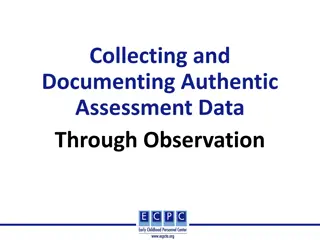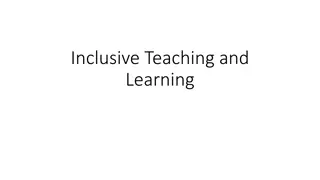Enhancing Student Learning Through Authentic Assessment in University Settings
Authentic assessment in university classrooms focuses on students applying knowledge to real-life situations, validating career choices, fostering engagement, and demonstrating competency. It helps students contextualize their learning, solve real-world problems, and value assessment authenticity over traditional methods like essays and exams.
Download Presentation

Please find below an Image/Link to download the presentation.
The content on the website is provided AS IS for your information and personal use only. It may not be sold, licensed, or shared on other websites without obtaining consent from the author.If you encounter any issues during the download, it is possible that the publisher has removed the file from their server.
You are allowed to download the files provided on this website for personal or commercial use, subject to the condition that they are used lawfully. All files are the property of their respective owners.
The content on the website is provided AS IS for your information and personal use only. It may not be sold, licensed, or shared on other websites without obtaining consent from the author.
E N D
Presentation Transcript
Authentic Assessment in the University Classroom CADAD / ACODE Joint Meeting Presented November, 2017
Authentic assessment focuses on students using and applying knowledge and skills attained in their course to real-life settings.
For example, you might have students take part in: simulation or role play of a scenario or case study completion of a real-world task assessment in a workplace setting
Authentic Tasks Validate the student s choice of program and eventual career Make them excited to become what they want to be Can produce student buy-in to their program having a positive affect on student retention.
Authentic assessment helps students contextualise their learning and to see how real-life situations, in all their unpredictability, ambiguity and complexity, affect their theoretical knowledge.
As students draw together their knowledge and skills engaging productively and solving authentic problems, their achievements clearly show, both to their teachers and themselves, their achievement of the stated learning outcomes, as well as the general competency they have gained.
Authenticity is a fundamental characteristic of good assessment practice and students usually value it highly. (and frankly, it s much more fun!)
More traditional forms of assessment, such as essays and examinations, have no specific application in most real-world settings.
The academic essay is perhaps the most commonly and frequently used assessment tool outside of tests and exams.
Why is the academic essay so popular as a university assessment tool?
Students describe the task as research
Classical Test (Assessment) Model Score = True Score + Error
Common sources of error in university assessment scores Plagiarism Subjective Grading Vague grading parameters Lack of clarity in assignment expectations Inconsistency of application of grading rubric Others?
Validity Does the assessment measure what it is supposed to measure?
Can the academic essay be seen to be valid? What challenges to validity exist with the academic essay?
Measuring Learning Outcomes or Essay Writing Skill? Too much emphasis on measuring non- authentic academic skills and behaviours? Grading focus often on mechanics of the essay and referencing, not meeting the learning outcomes of the course.
Reliability How consistent / fair / replicable is the assessment?
Practicality How much effort is it to write and/or assess/mark? (Is it worth it?)
Lets take a look at some examples of academic essay assignments
As you examine these essay assignments, please consider: What learning outcome(s) is/are being assessed? Are the requirements clear? Is the word limit appropriate for the task? How easy would this task be to plagiarise? What student characteristics might affect their performance? Should they?
Essay 50% | 2500 words Critically analyse the mechanisms of social inclusion and exclusion on workplace behaviour, and ways management can address the needs of socially and culturally diverse employees. Provide an overview of the mechanisms of social inclusion and exclusion. It must include: Evidence of the ways sociological factors intersect (illustrated by examples highlighting several sociological factors) Ways that the organisations can address social and cultural diversity (illustrated by examples of business structure and human resources practice) Reference to appropriate sociology theory and academic literature NOTE: course content does not include sociology theory
WORD LENGTH:1500 words WEIGHTING: 20% DESCRIPTION: We understand the term context to describe the situations and settings that define, develop, enhance and /or limit experience and opportunity. Across our lifespan we constantly move through a variety of contexts, each shaping us and being shaped by us. Contexts can include interpersonal relationships and/or physical settings. The multiple contexts in and through which children develop and families function are interrelated, responsive and dynamic, embedded within wider social, economic and political contexts (Zubrick et al, 2005, p.165). The task for INDIVIDUAL ASSESSMENT ITEM ONE is: to produce an ethnographic reflection critically discussing how your own development to date is likely to influence your experience of (i) the course content and (ii) your capacity to engage with group processes and work focused on this content. Your reflection should include discussion of your own developmental history from an ecological perspective identifying the individual, familial and community or neighbourhood influences on your experiences and how these are likely to shape and impact upon your learning in this course. NOTE: As this is a reflective piece it is appropriate to write this task in the first person. CRITERIA FOR ASSESSMENT: Demonstrated understanding of Ecological Systems Theory Critical reflection on own developmental experiences Demonstrated capacity for analytical thinking and ability to link self-reflection to course content and group process. Professional writing, grammar, spelling, and presentation; and correct referencing style
Critical analysis and reflection (20%) Assessment 1 requires you to critically analyse and reflect on a specified course reading. 800 words The reading you must analyse and reflect on is: Mayer, D. (2006). The changing face of the Australian teaching profession: New generations and new ways of working and learning, Asia-Pacific Journal of Teacher Education, 34(1), 57-71, What is the main argument the authors are making and what is your response to it? In order to answer this question you will need to: 1. Identify the main argument 2. Describe the key ideas and concepts (or line of reasoning) used by the authors to make the argument. 3. Evaluate the significance of the argument and the author s use of evidence to support it. 4. Reflect on what the argument means in relation to: a. The guiding question for the course b. What questions does the article raise for you as a future teacher? Ground Rules You must answer the question in essay form. You can write your essay using first or third person language conventions. You are not permitted to quote from the reading but you can paraphrase ideas. You must reference the Mayer (2006) reading within the essay and at the conclusion in a reference list, using APA 6th referencing style.
Assessment item 2: Health care professional practice scenario Word limit: 1500 words Weighting: 35% Purpose: This assessment item you will provide you with the opportunity to demonstrate your understanding and application of the key concepts in this course. Step 1: Locate and watch the clip Health care professional practice scenario . Step 2: You are to produce a written response in essay format that addresses the following: 1. From the content of this course clearly identify 3 major professional issues that are evident in the scenario. 2. Define and describe each issue with reference to nursing or midwifery literature and demonstrate how each is illustrated in the scenario. 3. For each identified issue provide 2 specific and realistic strategies that could improve professional practice in the scenario. For each strategy clearly state what needs to be done, who would be responsible for the strategy and what your strategy is aiming to achieve. Ground rules: Your essay will require an introduction and conclusion. You can use headings to structure the essay. These headings should be aligned with marking criteria in appendix II. Under each heading, your responses must refer to nursing and/or midwifery literature (e.g. nursing and/or midwifery journal articles and textbooks) and provide in-text references and a reference list in APA style. For this assessment item the following definitions will be used: Identify: Recognise and name Demonstrate: Show by example Define: State the meaning Describe: Identify the essential qualities Strategy: An action or actions to improve a situation or create a desired outcome
Academic Literacy 7 marks deducted Major problems throughout with many spelling mistakes or grammatical errors. and/or Incoherent sentence structure, little or no paragraph and/or assessment item structure. 4 marks deducted Recurring problems with spelling mistakes or grammatical errors. and/or Recurring problems with sentence, paragraph and/or assessment item structure. 2 marks deducted Occasional problems with spelling or grammar. and/or Occasional poor sentence or paragraph structure. 0 marks deducted Mainly error free. Minus Academic Integrity 7 marks deducted Sources not acknowledged or APA referencing not used or More than 10 per cent direct quotes May incur SACO referral. 4 marks deducted Consistent incorrect use of APA referencing in reference list or in-text referencing. 2 marks deducted Minor problems with referencing in reference list or in-text referencing. 0 marks deducted Mainly error free. Minus
What do people intend to measure with academic essays?
Or does measurement matter? Many will say that writing the essay is a formative, learning activity in and of itself. Is this true? What is the formative part? Searching the Literature and Reading Or Writing the essay in academic style?
Emphasis on Mechanics Much emphasis is often placed on the reference list itself, especially formatting. What does this measure and is it one of the learning outcomes of the course? Students can pass or fail on a hanging indent
Under what circumstances IS the essay the most appropriate assessment tool?
Exams are intended to measure learning, specifically achievement of learning outcomes Non-real world, high stress situation Few tasks in the real world are closed book There is a belief that setting formal exams will cause students to learn content
Is the handwritten exam an authentic measure of student achievement?
In what jobs are students not allowed to refer to resources when completing tasks or making decisions?
Could time memorising material for exams be spent preparing for more authentic tasks that will be replicated in the workplace?
Alternatives to the Essay and Exam Think Authentic Assessment Students want to know that their work in university is preparing them for the workplace What type of assessment will get your students pumped about their chosen discipline/career?
Examplesof Alternatives Reflections on the process At various times students turn in written descriptions of their research process. Problem solving approach What steps would be taken to solve a problem. Literature review Evaluative annotated bibliography. Science in the news Find evidence in literature for news release claims. Event initiated examples Evaluate a current event based on literature findings. Letter to the Editor Choose a newspaper/magazine and write an editorial.
Examplesof Alternatives Design a Theme for a Conference Describe why this topic would be of interest to experts in this field. Diary Entry From a famous person in your field/patient with a disorder/legal client Evaluate thinking Have students discuss what they found and compare sources. Read and find facts Read an editorial, article, reflection and find facts to support it. Create a webpage Select a topic to do with course content. Biography Select a scholar/researcher in field and report on career, influences, major ideas, moods and trends in research program.
Examplesof Alternatives Follow a piece of legislation through government processes What groups are lobbying for/against it and why? Follow a current foreign policy issue as it develops Have students adopt the perspective of one of the various groups involved and predict the next move. Nominate someone for a Nobel prize Justify nomination. Adopt a persona Write journal entries, letters, commentaries from that person s perspective Write a resume and cover letter (real or fictional) Find a relevant job posting in your field Write a presentation proposal Find a relevant scholarly or industry conference and write a proposal abstract. Write an exam Provide answers and justify rationale for questions asked.
Examplesof Alternatives Write a review of a performance, a movie, a book, a journal article, a guest speaker lecture Write a newspaper, magazine, Wikipedia, webpage story on a topic. Evaluate an article in a trade magazine (Psychology Today, Harvard Business Review) - Compared to findings in scholarly journals. Describe your dream job Have students research careers in the field and justify their choice of company, location, job, etc. Watch a movie or TV show Discuss how characters in different roles or procedures compare to national standards/how compare relationships to known models/theories Compare and contrast primary and secondary sources. Evaluate a website.
Examplesof Alternatives Compare and contrast the state of knowledge on a topic in two different decades or eras. Conduct research but don t write the final draft. Prepare for a hypothetical interview Have students do background research on a company or job offer and how they fit with job description. Compare and contrast the content, style, and audience of three different scholarly journals in a field. Compare and contrast a scholarly journal article with an article from a popular magazine. Prepare for an interview with a top figure in the field Justify questions, provide background notes. Compare and contrast the ways different disciplines deal with the same subject matter.
